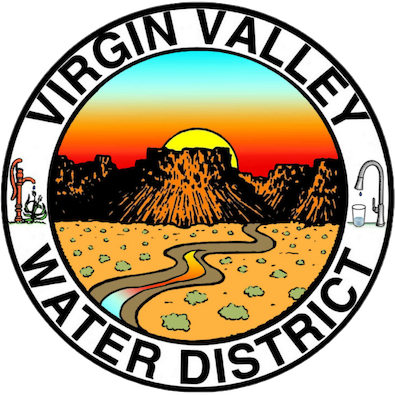Water Availability Status
Virgin Valley Water District – Water Availability Status
The extreme drought conditions that are plaguing the southwestern United States have been
making headlines around the country. The Colorado River and its tributaries are running at
historically low flows due to the lack of snow pack from last winter in Wyoming, Colorado, and
Utah. The two major water storage facilities on the Colorado River, Lake Mead and Lake Powell
are at historic low water levels. Yes, things are in dire shape for many communities, large and
small, in the southwest.
So what about Mesquite and Bunkerville? Fortunately, the Virgin Valley Water District (District)
does not depend on the Colorado River or its tributaries for our culinary water supply. The
District does own some shares in the Mesquite and Bunkerville Irrigation Companies that are
currently leased to local farmers, golf courses, and Southern Nevada Water Authority. Those
irrigation shares are on the Virgin River, a tributary of the Colorado River. One day when
needed, the District will utilize those Virgin River shares for culinary water needs. That is
planned to be in the 2030 timeframe.
In the meantime, the District currently provides water for residents and businesses in Mesquite
and Bunkerville from wells drilled deep into the aquifer below. The District currently has nine
operational wells with two more that have been drilled, but not equipped yet. The water from
the wells supplies sufficient water for the residential and commercial bathing, drinking,
irrigating, and cooking needs in the area. And due to historical conservation measures
implemented early in the residential growth years (desert landscaping, low flow plumbing
fixtures, smaller sized homes and building lots, 100% treated wastewater reuse for irrigation,
etc.), the residential metered use of 0.34 acre-feet per equivalent residential dwelling unit is on
par with many of the leading water conservation communities in the Southwest.
While we as a community overall are doing well, we can always improve, and we should. Things
such as reducing unnecessary turf, replacing high water need foliage with more drought
tolerant plants, being more efficient in outdoor watering, and making adjustments to indoor
water use are starting points.
So how is the health of the aquifer? The District has many groundwater monitoring wells
throughout the valley to determine if the aquifer is being stressed. The District monitors the
wells on a monthly basis. Based on the current pumping rate (the District pumps about 7,000
acre-feet of water per year), the aquifer’s static water level has not appreciably changed over
the past several decades. In addition to the groundwater monitoring wells, the District has
multiple remote mountain peak precipitation gages to monitor precipitation levels. Ultimately,
the precipitation received in the surrounding mountains (snow or rain) becomes the water that
recharges our aquifer.
The District is in the process of performing a Perennial Yield Study of the aquifer to improve on
several older studies to determine what the safe yield of the aquifer is. The results of the study
won’t be available until late 2024. Some existing studies indicate that there may be additional
groundwater that could be allocated to the District in the future for additional growth
purposes.
Eventually the growth won’t be sustainable and will have to stop. Based on our Master Plan
(see Table 3-10 on page 3-10), the Virgin Valley’s population will eventually be between 50,000
– 70,000 residents. There are a variety of factors in play which is why there is such a large range
of low and high projections.
The bottom line is the Virgin Valley Water District is in great shape to deal with the drought,
climate change, and growth for the foreseeable future. The District will continue to be vigilant
in monitoring the aquifer levels and precipitation amounts, and when necessary, advise the
local planning authorities when the need to curtail growth should happen.

